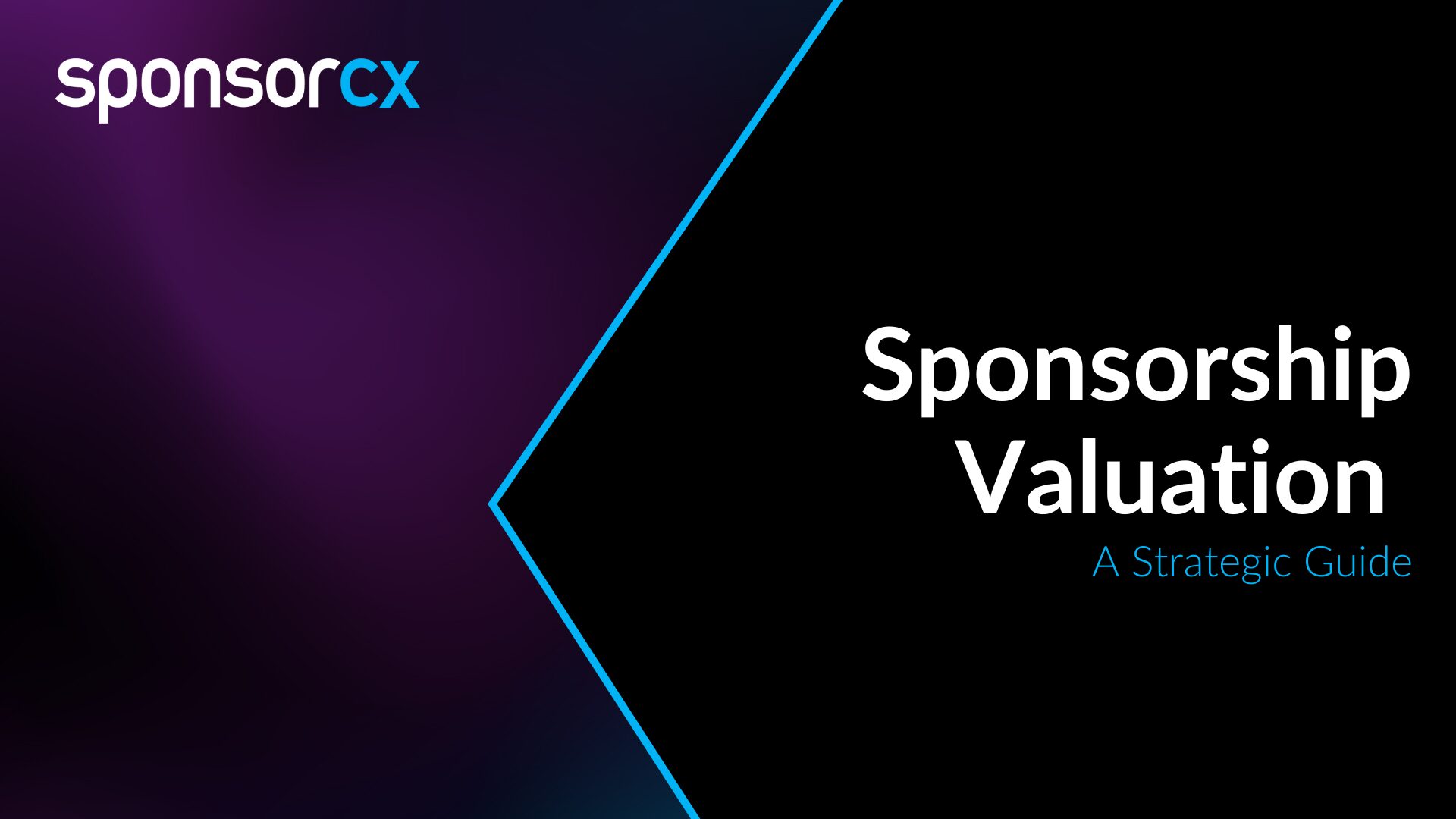Mastering Property Sponsorship Valuation — A Strategic Guide
Recently, a friend started a non-profit organization to educate students in the ever-changing tech space. As we sat down to discuss his plans, he spoke passionately about wanting to change lives for the better.
His biggest concern was supporting the effort financially, and he needed to figure out how to raise money. We discussed the need for an integrated sponsorship effort. It became evident that he did not know how to value his potential sponsorship assets.
Determining the value of property assets can be a complex and daunting task. On the property side, we must identify specific inventory assets and devise a solid valuation plan. On the marketing side, sponsorships are notoriously difficult advertising tools to valuate without supporting metrics. The trick is to find common ground.
Sponsors require more ROI for sponsorship investments than ever before. So, they’ve begun doing their own asset valuations. For properties and marketers alike, there are many ways to skin this cat. Wouldn’t it be nice to have a mathematical formula? One that you could plug your data into and come up with accurate and reliable results that everyone agrees on? Unfortunately, there isn’t one.
Mutual agreement on sponsorship valuation requires a well-thought-out approach. Both sides must consider the various factors contributing to their overall value. In this guide, we’ll outline how to determine sponsorship values for a property.
Understanding Sponsorship Valuation
Understanding sponsorship valuation is crucial for maximizing the benefits of sports and other sponsorship property assets. There are seven basic steps.
- Identify and define each asset, considering its visibility, audience engagement, and brand alignment.
- Reach valuation consensus through collaboration and stakeholder engagement through honest discussion that includes verifiable data.
- Organize and categorize assets based on their characteristics and potential return on investment. This helps prioritize and structure sponsorship packages.
- Validate valuations using real-world data, such as past performance metrics, market trends, and industry benchmarks. This step is essential to ensure the proposed values are realistic and defensible.
- Price the assets and develop a comprehensive rate card detailing each asset’s cost and value proposition. Transparency aids in negotiations and provides a clear framework for potential sponsors.
- Develop fulfillment and activation strategies to ensure assets deliver the promised value. Effectively executing these strategies is key to maintaining sponsor satisfaction and achieving desired outcomes.
- Continue to monitor and adjust valuations and strategies based on performance feedback and market changes. Ongoing evaluation ensures the sponsorship program remains dynamic and responsive to evolving market conditions, optimizing value for all parties involved.
SponsorCX offers comprehensive, easy-to-use tools to streamline and enhance your sponsorship management efforts. Contact us to schedule a demo and discover how we can help maximize your sponsorship strategies. Now, let’s take a closer look at each of these steps.
Detailed Guide to Property Sponsorship Valuation
Step 1: Identify and Define Property Assets
Begin by conducting a thorough inventory of all assets associated with the sports or sponsorship property. Assets can be tangible, such as stadium signage, merchandise, and hospitality areas, or intangible, like brand association, digital content, and exclusive experiences.
Take, for instance, the partnership between Manchester United and Chevrolet. Manchester United meticulously identifies and defines its assets, including stadium banners, player appearances, digital media rights, and social media content. Each asset is evaluated for its potential to deliver brand exposure and engagement.
Once assets are identified, clearly define their attributes and benefits. For example, digital content assets include website banners, social media posts, and email newsletters, each offering unique engagement opportunities. Define the reach and engagement potential of these assets using sponsorship analytics. Look for audience demographics, engagement rates, and historical performance.
When defining asset attributes and benefits, you create a clear framework for evaluating sponsorships. You can provide a compelling and data-driven justification for each asset’s value using real-world examples and sponsorship analytics.
Step 2: Collaborate With and Engage Stakeholders
Begin by organizing workshops or meetings with key stakeholders, including team members, sponsors, and industry experts. Focus these sessions on discussing the value of various assets, guided by data from sponsorship analytics. Present empirical data on past performance, audience engagement, and sponsorship ROI to provide a solid foundation for discussions.
When the English Premier League (EPL) negotiates sponsorship deals, it engages with major sponsors like Nike and Barclays to evaluate the value of its sponsorship assets. The league presents detailed analytics on TV viewership, stadium attendance, and social media interactions. All parties understand the tangible and intangible benefits of each asset.
In your discussions, encourage stakeholders to share their perspectives and experiences. Discuss any discrepancies between perceived and actual value to arrive at a consensus. This will help you quickly spot potential gaps and areas needing improvement. Use feedback to ensure your asset valuations are realistic and market-aligned.
You achieve consensus by balancing different viewpoints and finding common ground. Encourage open dialogue, address concerns promptly, and be willing to adjust valuations based on stakeholder input.
Step 3: Organize and Categorize Assets
Begin by inventorying all available assets and categorizing them into tangible and intangible categories. Tangible assets include physical items like signage, merchandise, and VIP hospitality areas. Intangible assets encompass elements such as brand association, media exposure, and unique experiences.
The NBA categorizes its assets into different tiers based on visibility and engagement potential. Courtside signage, digital media rights, and exclusive events like the NBA All-Star Weekend are categorized to reflect their unique values. This organized approach aids in effectively evaluating sponsorships and crafting targeted sponsorship packages.
Next, prioritize assets based on their potential ROI. Utilize sponsorship analytics to assess historical performance data. Include audience reach, engagement levels, and brand impact. Assets consistently delivering high ROI should be prioritized and priced higher to reflect their premium value.
Categorizing also helps identify unique opportunities that can be leveraged for maximum impact. For example, exclusive access to player meet-and-greets or behind-the-scenes content can be positioned as high-value offerings due to their limited availability and high fan engagement potential.
Regularly review and update your asset categories to align with market trends and sponsor feedback. This will ensure that your sponsorship offerings remain competitive and relevant, maximizing the value of sponsorships.
When systematically organizing and categorizing assets, you create a clear and strategic framework that enhances sponsorship valuation, supports your pricing strategies, and ultimately drives higher sponsorship ROI.
Step 4: Validate Valuations
Start by gathering data on each asset’s past performance. Use sponsorship analytics to evaluate key metrics such as audience engagement, brand exposure, and direct sales impact. During the Olympics, companies like Visa and Coca-Cola utilize extensive data analytics to measure the effectiveness of their sponsorships. By analyzing viewership numbers, social media engagement, and consumer purchase behavior, these companies can validate the value of their sponsorship investments.
Another approach is benchmarking against industry standards. Compare your asset valuations with similar sponsorships in your sector to ensure they are competitive. Benchmarking helps identify discrepancies and align your valuations with market trends.
Seek feedback from sponsors and stakeholders. Their insights can provide valuable context on sponsorship assets’ perceived value and actual performance. If a sponsor reports significant brand lift and consumer engagement from a particular asset, perhaps you can increase its valuation.
Once you have gathered and analyzed this data, adjust your valuations accordingly. If the data shows that certain assets consistently deliver high ROI, consider increasing their value. On the other hand, if some assets underperform, reassess their valuation or explore ways to enhance their effectiveness.
By validating asset valuations with real-world data and stakeholder feedback, you ensure your sponsorship valuation is accurate and credible.
Step 5: Price Your Assets and Create a Rate Card
First, use sponsorship analytics to gather historical data on each asset’s performance. Include audience reach, engagement levels, and previous sponsorship ROI. This data-driven approach allows you to evaluate sponsorship values accurately.
During the NFL season, the Dallas Cowboys use a detailed rate card to price their various sponsorship assets, including stadium signage, digital media, and promotional events. By analyzing past performance data and market demand, they assign prices that reflect each asset’s true value and potential return.
Once you have this data, refer to the assets you’ve categorized based on their nature — tangible or intangible — and their potential impact. Tangible assets like physical signage or merchandise typically have straightforward pricing based on production and exposure costs. Intangible assets, such as brand associations and exclusive experiences, require a more nuanced valuation, considering their long-term brand impact.
Create a comprehensive rate card listing each asset, price, and detailed description. Include expected ROI and supporting data from sponsorship analytics. Transparency in pricing helps build trust with potential sponsors.
Review and update the rate card regularly to reflect market trends, feedback, and performance data. If a particular asset, like social media integration, consistently shows high engagement and ROI, its price may need to be adjusted upward.
By carefully pricing assets and maintaining an up-to-date rate card, you ensure your sponsorship offerings remain competitive and appealing.
Step 6: Develop Fulfillment and Activation Strategies
Start by aligning activation strategies with the sponsor’s objectives. Make sure that every activity enhances the value of the sponsorship. Use sponsorship analytics to understand the target audience’s preferences and behaviors. Then, craft tailored activation plans that resonate.
A real-world example is the partnership between Coca-Cola and the FIFA World Cup. Coca-Cola leverages its sponsorship by creating engaging fan zones at stadiums, complete with branded experiences, interactive games, and exclusive merchandise. Brand visibility increases and fans also have memorable experiences that enhance the perceived value of the sponsorship.
Create a detailed plan outlining each step of the activation process. Include clear timelines and responsibility assignments, along with defined and measurable goals. Effective communication with sponsors is crucial throughout this process to ensure that expectations are met and needed adjustments are made promptly.
Utilize both physical and digital channels to maximize reach and engagement. Complement on-site activations with social media campaigns and exclusive online content that amplifies the sponsor’s message. Monitor the activation’s performance in real time using sponsorship analytics. Allow for immediate tweaks to optimize results.
After the activation, provide a report detailing the outcomes, using data to highlight key metrics such as engagement levels, brand awareness, and ROI. This transparency demonstrates the value of sponsorships and builds trust, fostering long-term partnerships.
When you plan and execute fulfillment and activation strategies, you enhance the value of sponsorship assets and ensure that sponsors achieve their objectives.
Step 7: Continue to Monitor and Adjust
Continuous monitoring and adjustment are essential for maintaining accuracy and relevance. Use sponsorship analytics to track performance metrics like audience engagement, brand visibility, and sales impact. This real-time data allows you to assess the sponsorship ROI and identify areas for improvement.
Consider a major sports event like the Super Bowl. Sponsorship managers continuously monitor the performance of various sponsorship assets, such as stadium signage, TV ads, and social media campaigns. By analyzing viewership data, social media mentions, and audience engagement, they can evaluate the effectiveness of each asset. If a particular social media campaign drives higher engagement than expected, its value may be increased for future events.
On the other hand, if stadium signage isn’t delivering the expected ROI, adjustments can be made to enhance its visibility or reduce its cost. This dynamic approach ensures that sponsorships’ value accurately reflects their market performance and impact.
Regularly updating sponsorship valuations based on real-world data helps maintain competitive pricing and maximizes the value of sponsorships. Continuous improvement cycles, grounded in sponsorship analytics, foster adaptive and effective sponsorship programs that deliver high ROI for sponsors.
Two Relevant Case Studies
2012 London Olympic Games
The London 2012 Olympic Games organizing committee utilized media equivalency analysis and market benchmarking to assess the value of various sponsorship tiers. Detailed sponsorship analytics provided sponsors with a clear understanding of potential return on investment. Through its rigorous evaluation process, the London Olympics secured significant sponsorship deals. Accurate valuation maximizes revenue and builds strong, long-term partnerships built on trust.
Golden State Warriors
Another example is the NBA’s Golden State Warriors. When the team moved to the Chase Center in San Francisco, it used sponsorship analytics to assess the potential value of the team’s assets. It considered factors like fan engagement, media reach, and the premium location of the new arena. The detailed approach helped the Warriors understand the real value of their sponsorship offerings.
They created tailored packages for sponsors. The Warriors’ agreement with Rakuten for jersey patch sponsorship topped $40 million in the 2022-23 season. By accurately valuing their sponsorship assets, the Warriors maximize revenue and build strong, mutually beneficial partnerships.
The Bottom Line
The seven-step process we’ve outlined will help you accurately determine the value of your sponsorship assets. By following it, you’ll enable lasting, mutually beneficial partnerships. Visit our blog for more insights into sponsorship strategies and success stories. Better yet, request a demo to get started with our SponsorCX.











